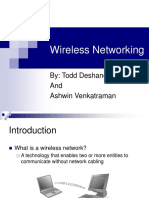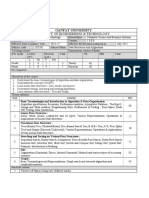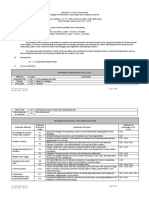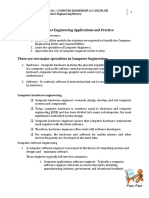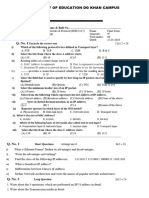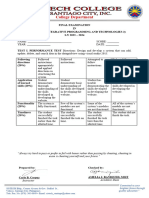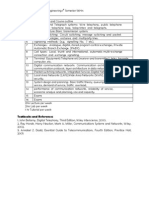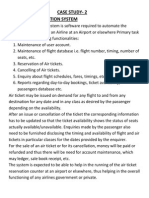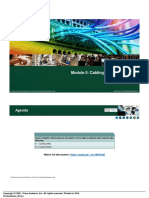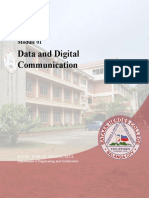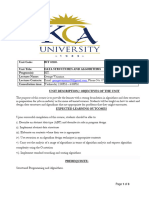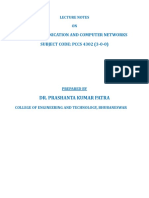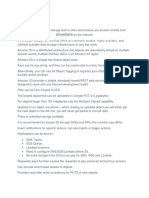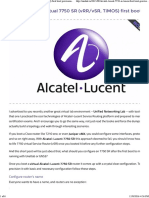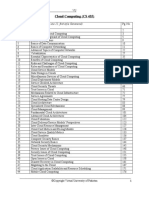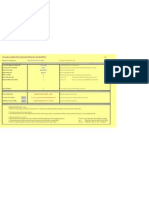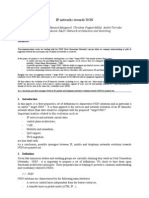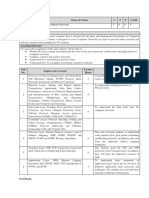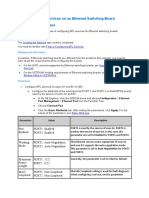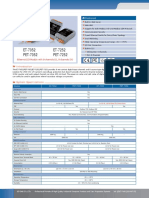Revision as per format MSRIT .F702 Rev. No.
2
M S Ramaiah Institute of Technology
Department of Computer Science and Engineering
COURSE DESIGN, DELIVERY AND ASSESMENT
Semester: IV
Course Code: CS415
Course Name: Data Communications
Course Faculty:
Sl#
Section
Course Faculty Name
1.
Mamatha V
2.
Sanjeetha R
3.
Mamatha V
Signature
Date
Course Coordinator
Mamatha V
Signature
Date
Program Coordinator
Dr. Anita Kanavalli
Signature
Date
�Revision as per format MSRIT .F702 Rev. No. 2
Head of Department (Sign & Date)
COURSE DESIGN, DELIVERY AND ASSESMENT
Course code and Title : CS415- Data Communication
CIE : 50 Marks
Total No of Theory / Tutorial / Lab Hours : 56/0/0
Prepared by : Mamatha V
Reviewed by : Dr. Anita Kanavalli
Course Credits 4:0:0
SEE : 100 Marks
Date : 21.01.15
Date : 22.01.15
Prerequisites
Prerequisite Courses with codes :NIL
Course Objectives:
The objective of the course is to:
1. Identify the components of a data communication system, factors which impact
performance of data communication systems and solve numerical examples related to
these.
2. Understand & Analyze Analog to Digital conversions and vice versa, Multiplexing and
various types of transmission media used in computer networks and methods to optimize
utilization of their capacities.
3. Understand the different types of circuit switched Networks and discuss various error
detection and correction techniques employed in data link layer
4. Analyze the various ARQ protocols, frame construction protocols like HDLC, PPP and
also the multiple access protocols employed by Data link layer.
5. Understand the structure of 802.3 and 803.11 protocols along with associated headers and
algorithms used and also learn about the connecting devices.
Syllabus
CS415: Data Communication
Credits: 4:0:0
Total Credits: 4
Unit 1
Data Communication: Networks, The Internet, Protocols and standards, Network Models - Reference
models OSI , TCP/IP Model, Addressing, Data & Signal - Analog and Digital, Transmission impairment,
Data Rate Limits, Performance
Unit 2
Digital Transmissions: Digital to Digital Conversions, Analog to Digital Conversions, Transmission
Modes, Analog Transmission, Digital to analog conversion, Analog to Analog conversion, Multiplexing
FDM, WDM, STDM, Statistical TDM, Spread Spectrum Guided Media Twisted pair cable, Co-axial
�Revision as per format MSRIT .F702 Rev. No. 2
cable, Fiber optic Cable, Unguided media : Wireless Radio waves, Microwaves, Infrared.
Unit 3
Circuit switched networks: Datagram networks, virtual circuit networks, Structure of a switch Structure
of Circuit Switches & Packet Switches. Data Link Layer - Error detection and Correction, Types of Errors,
redundancy, Detection v/s Correction, Forward error Correction v/s Retransmission, Block Coding - Error
detection and correction, Hamming Distance, Minimum Hamming Distance, Linear Block Codes, Cyclic
Codes CRC, Polynomials, Checksum.
Unit 4
Data Link Layer: Data Link Control Framing, Flow and error control, protocols, Noiseless Channels
Simplest protocol, Noiseless Channels Stop and wait protocol, Noisy Channel Stop and wait Automatic
Repeat Request, Go- back N Automatic Repeat Request, Selective Repeat, Automatic Repeat Request,
piggybacking, HDLC Configurations and Transfer Modes, Frames, Point to Point Protocols Framing,
Transition phases, Multiplexing, Multiple Access and Wired LANs-Random access Aloha, CSMA,
CSMA/CD,CSMA/CA, Controlled access reservation, polling, token passing, Channelization FDMA,
TDMA, CDMA.
Unit 5
IEEE standards: Data link and Physical Layer, Standard Ethernet MAC sublayer, Standard Ethernet
physical layer, Bridged Ethernet, Switched Ethernet, Full duplex Ethernet, Fast Ethernet, Gigabit Ethernet
Wireless LANs, IEEE 802.11- Architecture, MAC sub layer, Addressing Mechanisms and physical layer,
Bluetooth Architecture, Bluetooth layers, Connecting Devices Hub, Repeater, Bridges, Bridges,
Switches, Router, Gateway, Backbone Networks Bus, Star, Connecting Remote LANs, Virtual LANs.
Text Book:
1. Data Communication and Networking, 4th Edition, McGrw Hill, , 2006.
Reference Books:
1. Data and Computer Communication, William Stallings, 8th Edition, Pearson Education, 2007.
2.
Introduction to Data Communications and Networking Wayne Tomasi, Pearson Education,
2005.
3. Communication Networks-Fundamental Concepts and key architectures, Alberto Leon-Garcia
and Indra Widjaja, Tata Mc-Graw-Hill 2nd Edition, Pearson Education, 2005
�Revision as per format MSRIT .F702 Rev. No. 2
Concept Map
�Revision as per format MSRIT .F702 Rev. No. 2
Course Contents and Lecture Schedule
Lesson No.
/Session No.
1.
2.
3.
4.
5.
6.
7.
8.
9.
10.
11.
12.
Topic
No. of
Hours
Unit - I
12 Hrs
Data Communications, Networks, The Internet
Protocols and standards, Network Models , Introduction to
OSI Reference model
Physical layer, data link layer, network layer
Transport layer, session layer, presentation layer, application
layer
TCP/IP Model, Addressing
Connecting Devices Hub, Repeater, Bridges
Connecting Devices Bridges Contd., Switches, Router,
Gateway
Backbone Networks Bus, Star, Connecting Remote LANs,
Virtual LANs
Circuit switched networks
1 Hr
1 Hr
1 Hr
1 Hr
1 Hr
1 Hr
1 Hr
1 Hr
1 Hr
Datagram networks, Virtual circuit networks
1 Hr
Virtual circuit networks Contd., Structure of Circuit Switches
1 Hr
Exercises on above topics
1 Hr
Unit - II
11 Hrs
13.
Structure of Circuit Switches Contd., Structure of Packet
Switches
1 Hr
14.
Introduction : Types of Errors, redundancy, Detection VS
Correction, Forward error Correction VS Retransmission
1 Hr
15.
Block Coding - Error detection and correction, Hamming
Distance, Minimum Hamming Distance
1 Hr
16.
Linear Block Codes
1 Hr
�Revision as per format MSRIT .F702 Rev. No. 2
17.
Cyclic Codes CRC
1 Hr
18.
Cyclic Codes Contd. Polynomials, Checksum
Data Link Control - Framing, Flow and error control,
protocols
1Hr
19.
20.
Noiseless Channels Simplest protocol
21.
Noiseless Channels Stop and wait protocol
22.
Noisy Channel Stop and wait protocol
23.
Exercises on above topics
1 Hr
1 Hr
1 Hr
1 Hr
1 Hr
Unit - III
11 Hrs
24.
Automatic Repeat Request
1 Hr
25.
Go- back N Automatic Repeat Request
1 Hr
26.
Selective Repeat Automatic Repeat Request,
1 Hr
27.
piggybacking, HDLC Configurations and Transfer Modes,
Frames
1 Hr
Point to Point Protocols Framing, Transition phases
1 Hr
Point to Point Protocols Contd. - Multiplexing, Authentication
protocols
1 Hr
Random access pure Aloha
1 Hr
Slotted Aloha, CSMA
1 Hr
CSMA/CD
1 Hr
33.
CSMA/CA Controlled access reservation, polling, token
passing
1 Hr
34.
Exercises on above topics
28.
29.
30.
31.
32.
1 Hr
Unit - IV
35.
36.
11 Hrs
Channelization FDMA, TDMA
1 Hr
CDMA
1 Hr
�Revision as per format MSRIT .F702 Rev. No. 2
37.
IEEE standards Data link and Physical Layer
Standard Ethernet MAC sublayer
38.
1 Hr
1 Hr
Bridged Ethernet, Switched Ethernet, Full duplex Ethernet,
Fast Ethernet, Gigabit Ethernet
1 Hr
IEEE 802.11- Architecture, MAC sub layer
1 Hr
MAC sub layer Contd.
1 Hr
42.
Addressing Mechanisms
1 Hr
43.
Bluetooth Architecture,
1 Hr
44.
Bluetooth layers
1 Hr
39.
40.
41.
45.
1 Hr
Exercises on above topics
Unit - V
46.
47.
48.
Data & Signal - Analog and Digital
Analog and Digital(Contd)., Transmission impairment
Date Rate Limits, Performance
11 Hrs
1 Hr
1 Hr
1 Hr
49.
Digital Transmissions Digital to Digital Conversin
1 Hr
50.
Digital Transmissions (Contd) Analog to Digital
Conversions
1 Hr
51.
Analog Transmissions Digital to Analog Conversions
1 Hr
52.
Analog Transmissions (Contd) Analog to Analog
Conversions
1 Hr
53.
Transmission Modes
54.
Multiplexing FDM,WDM,STDM, Statistical TDM
55.
Multiplexing SPREAD SPECTRUM
56.
Guided Media Twisted pair cable, Co-axial cable, Fibre
optic Cable, Unguided media Wireless Radio waves,
Microwaves, Infrared.
1 Hr
1 Hr
1 Hr
1 Hr
�Revision as per format MSRIT .F702 Rev. No. 2
Course Outcomes:
At the end of the course the student will be able to:
1. Identify and recognize the ISO OSI and TCP models and the layers associated
functionalities.
2. Understand and analyze the types of digital transmissions and also know in detail about
the types of transmission media.
3. Recognize the different types of networks and learn to solve problems in Error detection
and corrections carried at data link layer.
4. Design algorithms for the different ARQ protocols and also able to know the detailed
frame format of HDLC and PPP.
5. Recognize the different types of Ethernet and get to understand the architecture of
different types of wireless networks.
Mapping Course Outcomes with program Outcomes:
Course Learning Objectives
Program Outcomes
PO
1
PO
2
PO
3
PO
4
PO
5
PO
6
PO
7
PO
8
PO
9
PO1
0
PO1
1
PO1
2
1. Identify and recognize
the ISO OSI and TCP
models and the layers
associated functionalities
2. Understand and analyze
the types of digital
transmissions and also
know in detail about the
types of transmission
media
3.
Recognize the different
types of networks and
learn to solve problems
in Error detection and
corrections carried at
data link layer.
Design algorithms for the
different ARQ protocols
and also able to know the
detailed frame format of
HDLC and PPP.
Recognize the different
types of Ethernet and get
to understand the
architecture of different
types of wireless
4.
5.
�Revision as per format MSRIT .F702 Rev. No. 2
networks.
Course Assessment and Evaluation:
Direct Assessment Methods
What
To Whom
Internal
Assessment Tests
CIE
When/ Where
(Frequency in the
course)
Thrice(Average of the
best two will be
computed)
Max
Marks
Evidence
Collected
Contribution to Course
Outcomes
30
Blue Books
1,2,3,4,&5
once
20
Assignment &
Lab Answer
Sheets
1,2,3,4,5
End of Course
(Answering
5 of 10 questions)
100
Answer scripts
1,2,3,4,& 5
End of the course
Questionnaire
1,2,3,4, &5 Effectiveness
of Delivery of
instructions &
Assessment Methods
Assignment, Practical
Implementation
Students
SEE
Standard Examination
End of Course
Survey
Questions for CIE and SEE will be designed to evaluate the various educational components
(Blooms taxonomy) such as:
CIE and SEE evaluation
S.N
o
Blooms Category
Test 1
(30M)
Test 2
(30M)
Test 3
(30M)
Remember
20
Understand
20
Apply
25
Analyze
25
Evaluate
10
Create
10
Name
Implementation of UML Semester-End
Models using RSA/any Examination
Design tool.
(100M)
(20M)
Signature with Date
�Revision as per format MSRIT .F702 Rev. No. 2
Prepared by
Reviewed by
Mamatha V
Dr. Anita Kanavalli

